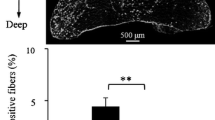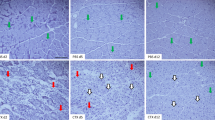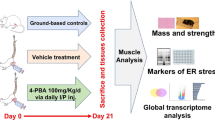Abstract
The recovery of metabolic pathways after muscle damage has been poorly studied. We investigated the myosin heavy chain (MHC) isoform transitions and the recovery of citrate synthase (CS) activity, isoform distribution of lactate dehydrogenase (LDH) and creatine kinase (CK) in slow muscles after two types of injury. Muscle degeneration was induced in left soleus muscles of male Wistar rats by either notexin injection or crushing and the regenerative process was examined from 2 to 56 days after injury. Myosin transition occurred earlier after notexin than after crush injury. Fast-type IIx and more particularly type IIa MHC isoform disappeared by day 28 after notexin inoculation, while they were still detected long after in crushed muscles. A full recovery of both the CS activity and the specific activity of the H-LDH subunit was observed from day 42 in notexin-treated muscles, while values measured in crushed muscles remained significantly lower than in non-injured muscles (P > 0.05). The activity of the mitochondrial isoform of CK (mi-CK) was markedly affected by the type of injury (P > 0.001), and failed to reach normal levels after crush injury (P > 0.05). The results of this study show that the relatively rapid MHC transitions during regeneration contrasts with the slow recovery in the oxidative capacity. The recovery of the oxidative capacity remained incomplete after crush injury, a model of injury known to lead to disruption of the basal lamina and severe interruption of the vascular and nerve supply.
Similar content being viewed by others

References
Agbulut O, Li Z, Mouly V and Butler-Browne GS (1996) Analysis of skeletal and cardiac muscle from desmin knock-out and normal mice by high resolution separation of myosin heavy-chain iso-forms. Biol Cell 88: 131–135.
Allbrook D (1962) An electron microscopic study of regenerating skeletal muscle. J Anat 96: 137–152.
Bassaglia Y and Gautron J (1995) Fast and slow rat muscles degenerate and regenerate differently after whole crush injury. J Muscle Res Cell Motil 16: 420–429.
Bigard AX, Mateo P, Sanchez H, Serrurier B and Ventura-Clapier R (2000) Lack of coordinated changes in metabolic enzymes and myosin heavy chain isoforms in regenerated muscles of trained rats. J Muscle Res Cell Motil 21: 269–278.
Carlson BM (1986) Regeneration of entire skeletal muscles. Fed Proc 45: 1456–1460.
Carlson BM and Faulkner JA (1983) The regeneration of skeletal muscle fibers following injury: a review. Med Sci Sports Exerc 15: 187–198.
d' Albis A, Couteaux R, Janmot C, Roulet A and Mira JC (1988) Regeneration after cardiotoxin injury of innervated and denervat-ed slow and fast muscles of mammals.Myosin isoform analysis. Eur J Biochem 174: 103–110.
Grounds MD and McGeachie JK (1989) A comparison of muscle precursor replication in crush-injured skeletal muscle of Swiss and BALBc mice. Cell Tissue Res 255: 385–391.
Gutierrez JM, Ownby CL and Odell GV (1984) Pathogenesis of myonecrosis induced by crude venom and a myotoxin of Bothrops asper. Exp Mol Pathol 40: 367–379.
Harris JB, Johnson MA and Karlsson E (1975) Pathological responses of rat skeletal muscle to a single subcutaneous injection of a toxin isolated from the venom of the Australian tiger snake, Notechis scutatus scutatus. Clin Exp Pharmacol Physiol 2: 383–404.
Jarvinen M and Sorvari T (1975) Healing of a crush injury in rat striated muscle. 1. Description and testing of a new method of inducing a standard injury to the calf muscles. Acta Pathol Microbiol Scand [A ] 83: 259–265.
Lefaucheur JP and Sebille A (1995) The cellular events of injured muscle regeneration depend on the nature of the injury. Neuro-muscul Disord 5: 501–509.
McGeachie JK and Grounds MD (1987) Initiation and duration of muscle precursor replication after mild and severe injury to skeletal muscle of mice. An autoradiographic study. Cell Tissue Res 248: 125–130.
Megighian A, Germinario E, Rossini K, Midrio M and Danieli-Betto D (2001) Nerve control of type 2A MHC isoform expression in regenerating slow skeletal muscle. Muscle Nerve 24: 47–53.
Ocalan M, Goodman SL, Kuhl U, Hauschka SD and von der Mark K (1988) Laminin alters cell shape and stimulates motility and proliferation of murine skeletal myoblasts. Dev Biol 125: 158–167.
Sadeh M, Stern LZ, Czyzewski K, Finley PR and Russell DH (1984) Alterations in creatine kinase, ornithine decarboxylase, and transglutaminase during muscle regeneration. Life Sci 34: 483–488.
Sesodia S, Choksi RM and Nemeth PM (1994) Nerve-dependent recovery of metabolic pathways in regenerating soleus muscles. J Muscle Res Cell Motil 15: 573–581.
Sommer A and Rifkin DB (1989) Interaction of heparin with human basic broblast growth factor: protection of the angiogenic protein from proteolytic degradation by a glycosaminoglycan. J Cell Physiol 138: 215–220.
Srere PA (1969) Citrate synthase. Meth Enzymol 13: 3–11.
Stauber WT, Fritz VK, Burkovskaya TE and Ilyina-Kakueva EI (1992) Effect of spaceflight on the extracellular matrix of skeletal muscle after a crush injury. J Appl Physiol 73: 74S–81S.
Swett JE, Hong CZ and Miller PG (1991) All peroneal motoneurons of the rat survive crush injury but some fail to reinnervate their original targets. J Comp Neurol 304: 234–252.
Talmadge RJ and Roy RR (1993) Electrophoretic separation of rat skeletal muscle myosin heavy-chain isoforms. J Appl Physiol 75: 2337–2340.
Trask RV and Billadello JJ (1990) Tissue-specific distribution and developmental regulation of M and B creatine kinase mRNAs. Biochim Biophys Acta 1049: 182–188.
Veksler VI, Kuznetsov AV, Anflous K, Mateo P, van Deursen J, Wieringa B and Ventura-Clapier R (1995) Muscle creatine kinase-deficient mice. II. Cardiac and skeletal muscles exhibit tissue-specific adaptation of the mitochondrial function. J Biol Chem 270: 19921–19929.
Ventura-Clapier R, Kuznetsov A, Veksler V, Boehm E and Anfious K (1998) Functional coupling of creatine kinases in muscles: species and tissue specie city. Mol Cell Biochem 184: 231–247.
Vracko R and Benditt EP (1972) Basal lamina: the scaffold for orderly cell replacement. Observations on regeneration of injured skeletal muscle fibers and capillaries. J Cell Biol 55: 406–419.
Whalen RG, Harris JB, Butler-Browne GS and Sesodia S (1990) Expression of myosin isoforms during notexin-induced regenera-tion of rat soleus muscles. Dev Biol 141: 24–40.
Author information
Authors and Affiliations
Corresponding author
Rights and permissions
About this article
Cite this article
Fink, E., Fortin, D., Serrurier, B. et al. Recovery of contractile and metabolic phenotypes in regenerating slow muscle after notexin-induced or crush injury. J Muscle Res Cell Motil 24, 421–429 (2003). https://doi.org/10.1023/A:1027387501614
Issue Date:
DOI: https://doi.org/10.1023/A:1027387501614



